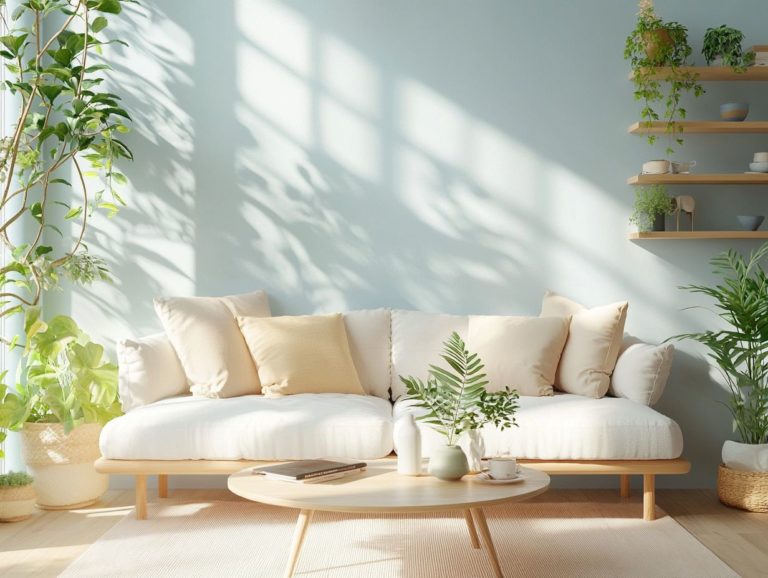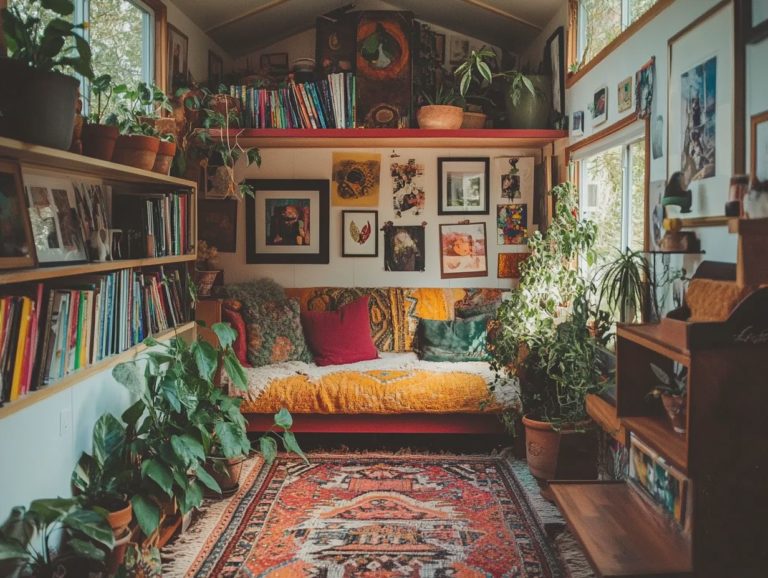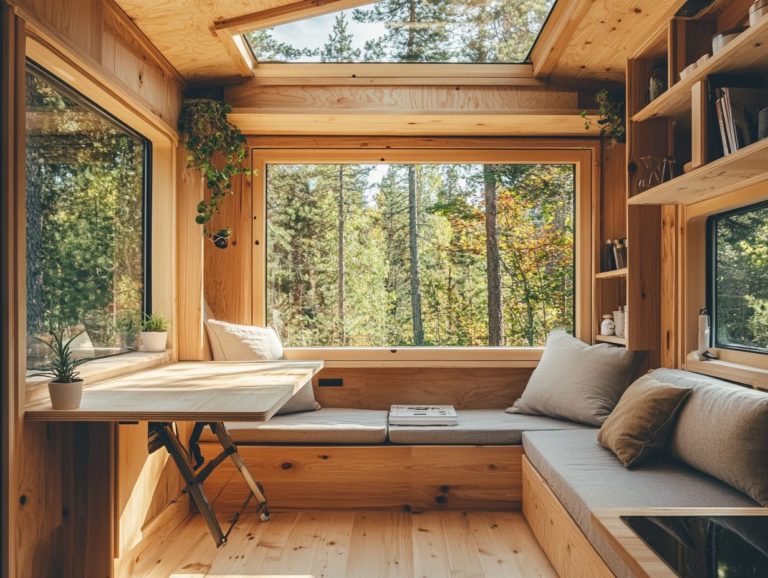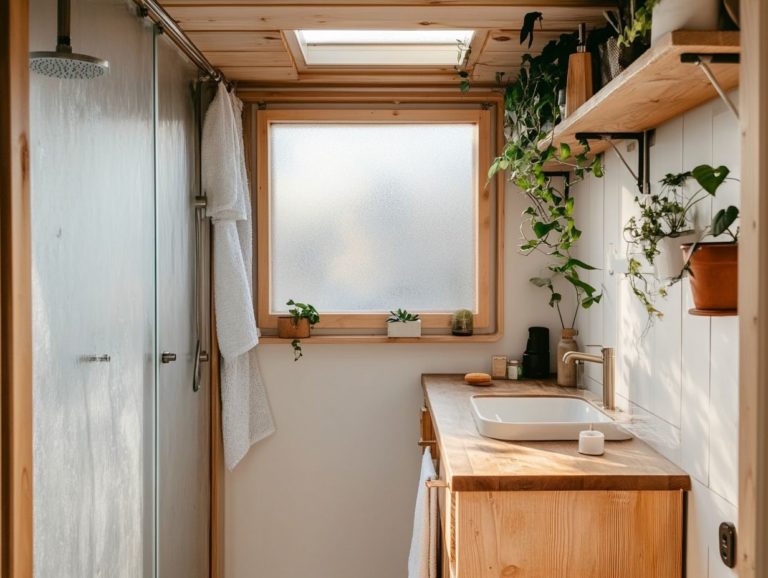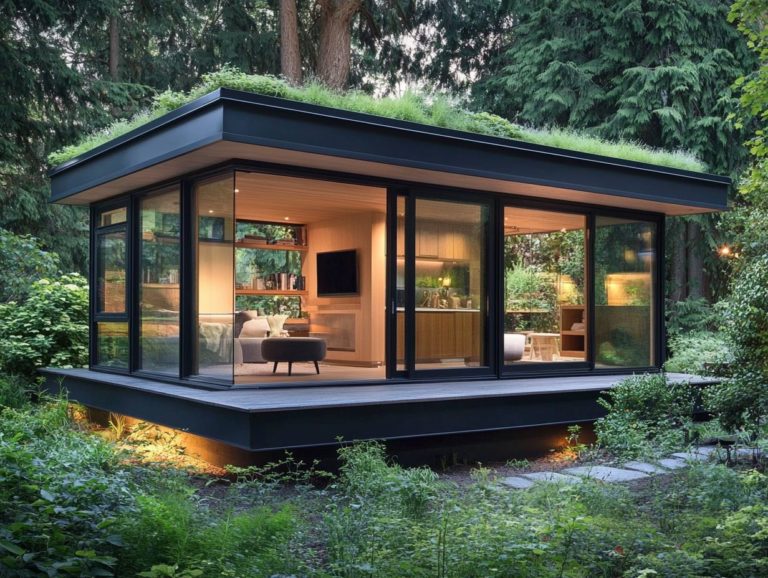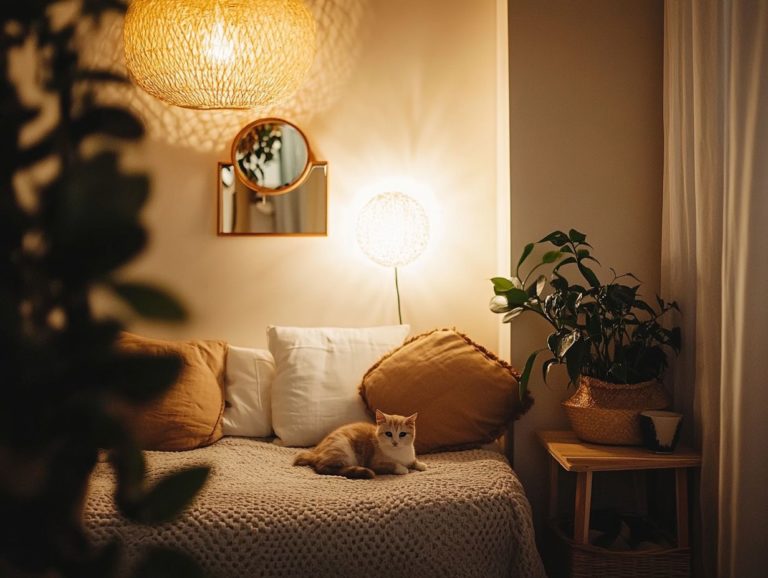5 Essential Design Elements for Tiny Living
In a world where every square foot counts, tiny living has become a sought-after and practical solution. Imagine a home where every corner inspires you!
Embracing a minimalist lifestyle doesn’t imply you have to give up comfort or style; instead, it opens the door to creativity and innovation in design.
This exploration reveals five essential design elements that can turn compact spaces into functional, inviting homes.
From multi-functional furniture to maximizing vertical space, you ll uncover the secrets to thriving in tiny living.
Prepare to rethink your approach to space!
Contents [hide]
- Key Takeaways:
- 1. Multi-Functional Furniture
- 2. Maximizing Vertical Space
- 3. Utilizing Natural Light
- 4. Creative Storage Solutions
- 5. Minimalism and Simplification
- What Is Tiny Living and Why Is It Popular?
- Frequently Asked Questions
- What are the 5 essential design elements for tiny living?
- How can multifunctional furniture enhance tiny living spaces?
- Why is space-saving storage important in a tiny living environment?
- What role does natural lighting play in tiny living design?
- How does a neutral color palette benefit tiny living design?
- How can vertical space be utilized effectively in tiny living design?
Key Takeaways:
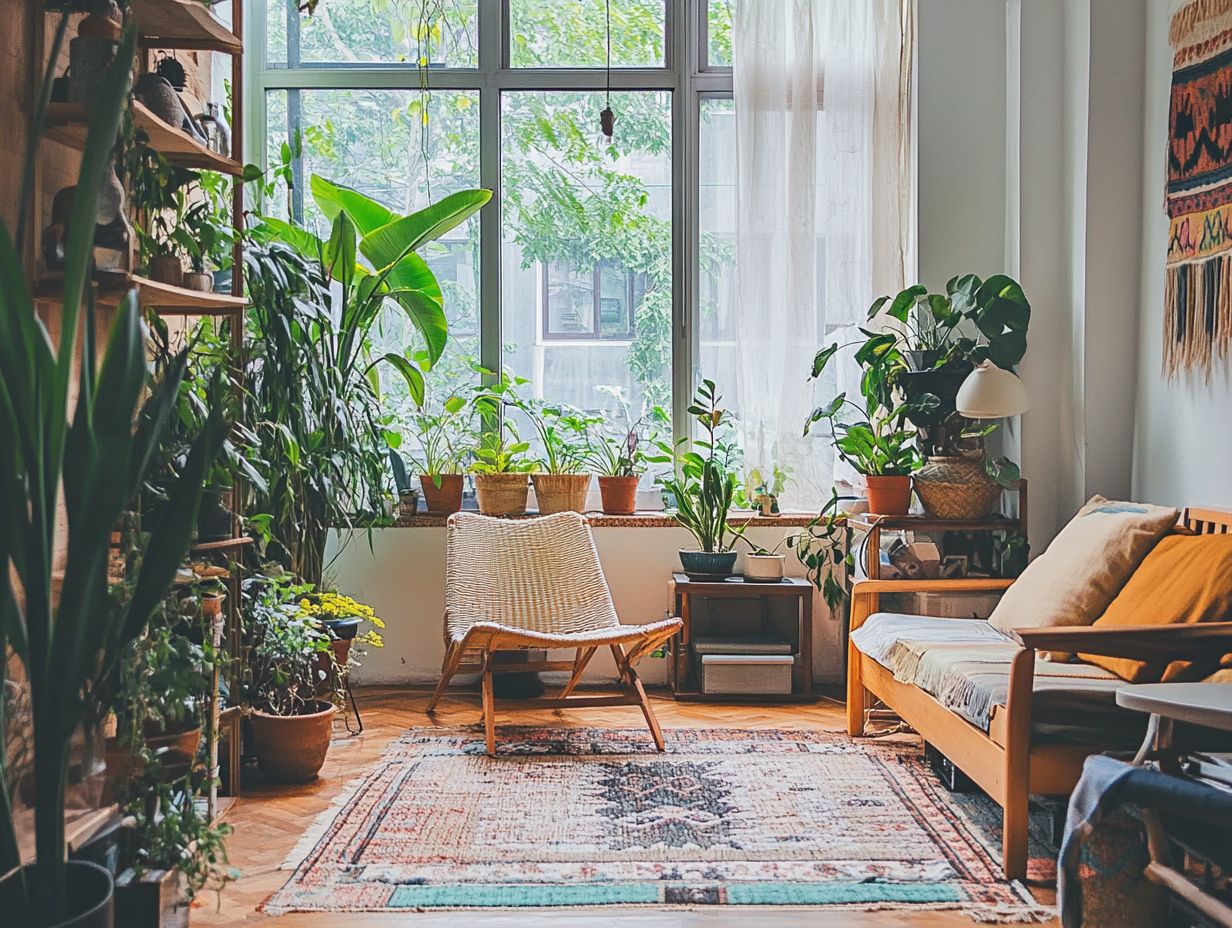
- Multi-functional furniture is crucial for maximizing space in tiny homes. Look for pieces that serve multiple purposes, such as a bed with built-in storage or a dining table that can also be used as a desk.
- Maximizing vertical space is key in tiny living. Use wall shelves, hanging organizers, and lofted beds to free up floor space. Be mindful of weight limits and ensure proper installation for safety.
- Natural light is a must-have in tiny living. Add windows, skylights, and light-colored walls to make the space feel larger and more open. Use sheer curtains for privacy while still allowing ample light to enter.
Start your tiny living journey today!
1. Multi-Functional Furniture
In the ever-evolving world of tiny homes, you ll find that multi-functional furniture stands as a cornerstone of effective design, allowing you to maximize your living space without compromising on comfort or style. Imagine fold-down tables and versatile sofas that easily convert into beds; these innovative solutions embody the principles of space optimization and efficiency, making them essential for anyone diving into the tiny house movement.
But it’s not just about saving square footage. This type of furniture often includes hidden storage compartments, creating a clutter-free oasis that promotes mental well-being. Picture a coffee table that transforms into a dining area this clever design doesn t just serve multiple purposes, it showcases the creative ingenuity that defines modern living.
Plus, eco-friendly materials add an enticing layer of appeal, offering both durability and sustainability while keeping aesthetics intact. As you prioritize quality in your tiny home, these stylish yet practical pieces become your critical allies in navigating the challenges of limited space. Consider incorporating 5 tips for designing tiny house bedrooms to maximize comfort and functionality.
2. Maximizing Vertical Space
Maximizing vertical space is an essential design tip for your tiny home, allowing you to make the most of every inch in your living area. By adding vertical storage solutions like wall-mounted organizers and shelves, you can keep your space organized and clutter-free while ensuring it remains both functional and visually appealing.
These solutions not only enhance the sense of openness but also provide easy access to daily essentials, saving you precious time that would otherwise be spent rummaging for items. Open shelving, which consists of shelves that are not enclosed, allows you to display items easily and can transform into a stylish display for your decorative pieces, seamlessly blending functionality with aesthetics.
Integrating these techniques aligns perfectly with a minimalist lifestyle, where every item has a purpose and contributes meaningfully to your overall design. By focusing on upward storage, you can create a serene atmosphere in your compact space, effectively managing clutter and crafting a harmonious home that truly reflects your personal style. To enhance your space further, explore 5 ways to personalize your tiny house design.
3. Utilizing Natural Light
Utilizing natural light is a cornerstone of tiny house design that not only elevates the aesthetic appeal but also enhances energy efficiency and overall well-being. By thoughtfully positioning windows and skylights while embracing an open floor plan, you can cultivate a bright and airy atmosphere that makes your living space feel larger than it is.
Incorporating larger windows, especially on south-facing walls, maximizes sunlight throughout the day. Reflective surfaces like mirrors can amplify this effect, bouncing light around your home and creating a vibrant ambience. This intentional design strategy does more than illuminate a room; research has shown it can elevate your mood, foster a sense of joy, and create a healthier living environment.
Minimizing reliance on artificial lighting promotes a more sustainable lifestyle, resulting in lower energy consumption and a reduced ecological footprint. Embracing natural light ultimately transforms your compact space into a welcome sanctuary, enhancing both comfort and functionality.
Embrace the tiny living revolution and discover how less truly can be more!
4. Creative Storage Solutions
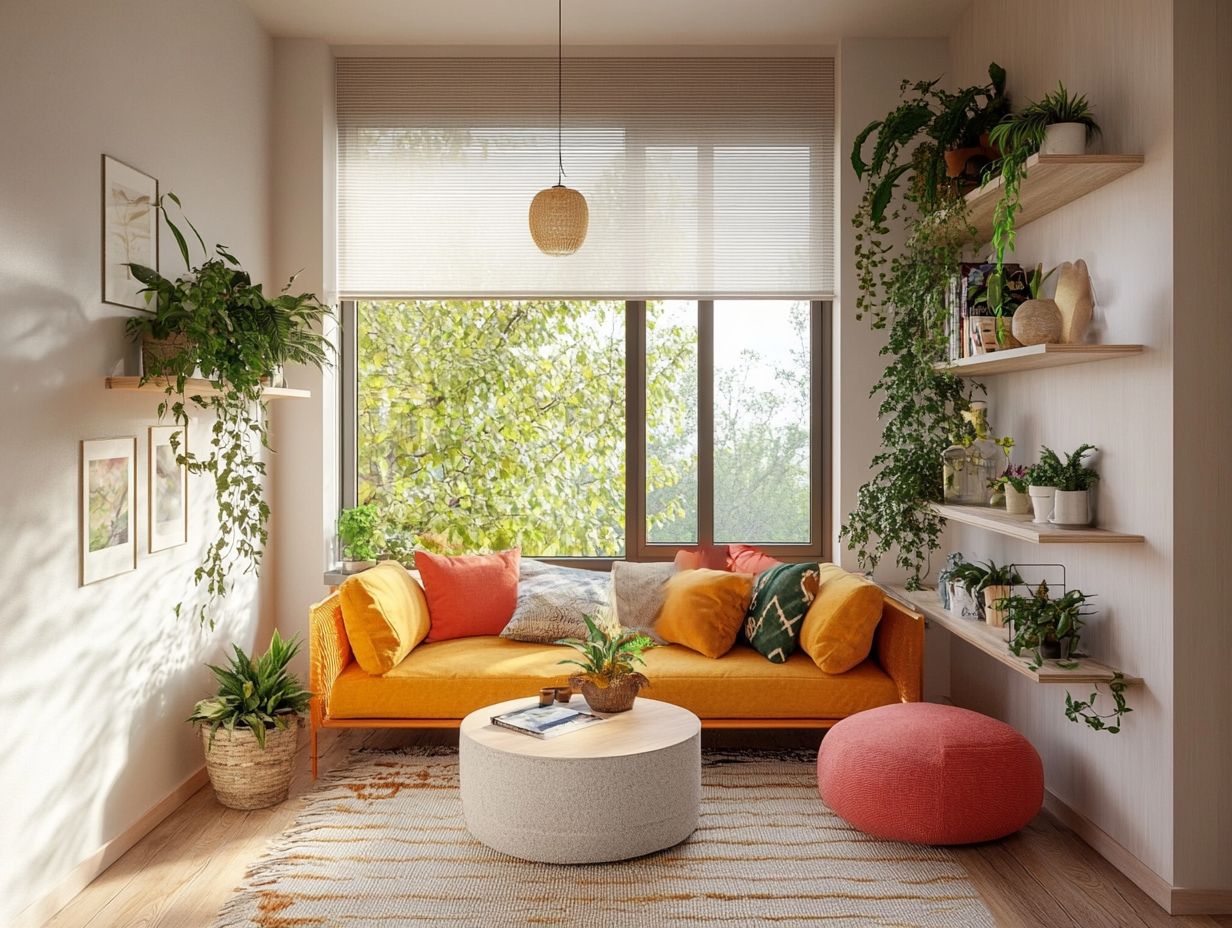
Creative storage solutions are essential in tiny living, enabling you to maintain organization and functionality within limited spaces. Innovative designs, such as portable walls and under-bed storage, allow you to maximize every inch while keeping your essential items easily accessible and neatly tucked away.
You might also consider multifunctional furniture, like ottomans that double as storage bins or coffee tables with hidden compartments, to elevate your living space. Incorporating DIY projects, such as wall-mounted shelves or custom cabinetry, lets you tailor your storage to suit your unique needs and aesthetic preferences.
These thoughtful strategies not only optimize your space but also significantly enhance efficient design. They reduce clutter and foster a harmonious atmosphere that supports a seamless living experience. For more ideas, check out 5 tips for cozy tiny house living rooms. With clever planning and creativity, you can strike a perfect balance between functionality and style in your tiny home.
5. Minimalism and Simplification
Minimalism and simplification lie at the core of the tiny house movement, inviting you to embrace a lifestyle that values quality over quantity and encourages you to declutter. By choosing to downsize and making intentional adjustments, you can unlock a sense of freedom and joy that comes from having fewer possessions and simplified living arrangements.
Living with less helps you organize your space. It also brings peace of mind. To manage clutter, start by identifying items that no longer serve a purpose and find a designated space for the essentials. This practice reinforces a sense of order in your life.
Embracing minimalism can yield significant emotional benefits, such as reduced anxiety and a heightened sense of well-being. With fewer distractions, you ll likely find it easier to connect with nature, pursue your hobbies, or spend quality time with loved ones. This ultimately enriches your daily experiences and promotes a more fulfilling lifestyle.
What Is Tiny Living and Why Is It Popular?
Tiny living is all about embracing the charm of small, efficient homes that prioritize sustainability and a minimalist lifestyle. Tiny living is gaining massive popularity as more people seek exciting new ways to live sustainably! This trend is driven by a desire for financial freedom, eco-conscious living, and the soaring costs of traditional housing.
You might find yourself exploring innovative design and community planning solutions that align with local regulations, making the most of every square foot.
As you delve into this lifestyle, are you ready to unlock the freedom that comes from tiny living? You’ll likely discover vibrant communities that cherish shared resources and communal activities, cultivating deep social connections. The perks of tiny living go beyond just saving money; they include a smaller carbon footprint, reduced energy consumption, and a heightened commitment to sustainable practices like upcycling (reusing materials creatively) and utilizing renewable materials. To enhance your experience, consider incorporating essential furniture for tiny house comfort into your space.
Local regulations are pivotal in this journey, as they can either nurture or stifle the growth of tiny housing communities. Zoning laws and building codes will dictate what you can and cannot do, shaping your tiny living experience.
Ultimately, the tiny house movement embodies a broader cultural shift that values experiences over possessions. It highlights a shared yearning for simplicity and connection within the community.
What Are the Challenges of Designing for Tiny Spaces?
Designing for tiny spaces presents you with unique challenges that demand innovative solutions, particularly when navigating building permits and local regulations. Adapting layouts and ensuring every element serves a purpose requires a careful balance between aesthetics and functionality, essential for executing efficient design principles successfully.
These challenges often extend to zoning laws, which may limit your options for where tiny homes can be placed. Spatial limitations call for creative problem-solving. Consider incorporating multi-functional furniture and maximizing vertical space. You can also explore minimalist decor ideas for tiny houses. Strategic planning becomes essential, allowing you to visualize how each square foot can be utilized effectively.
Understanding the needs and lifestyles of the occupants is key. This understanding leads to creating spaces that feel open and inviting, even in their compact nature. For inspiration, check out the top 10 tiny house interior design hacks. Ultimately, the art of tiny home design lies in transforming constraints into opportunities for innovative living solutions.
How Can Design Elements Help Maximize Space in Tiny Homes?
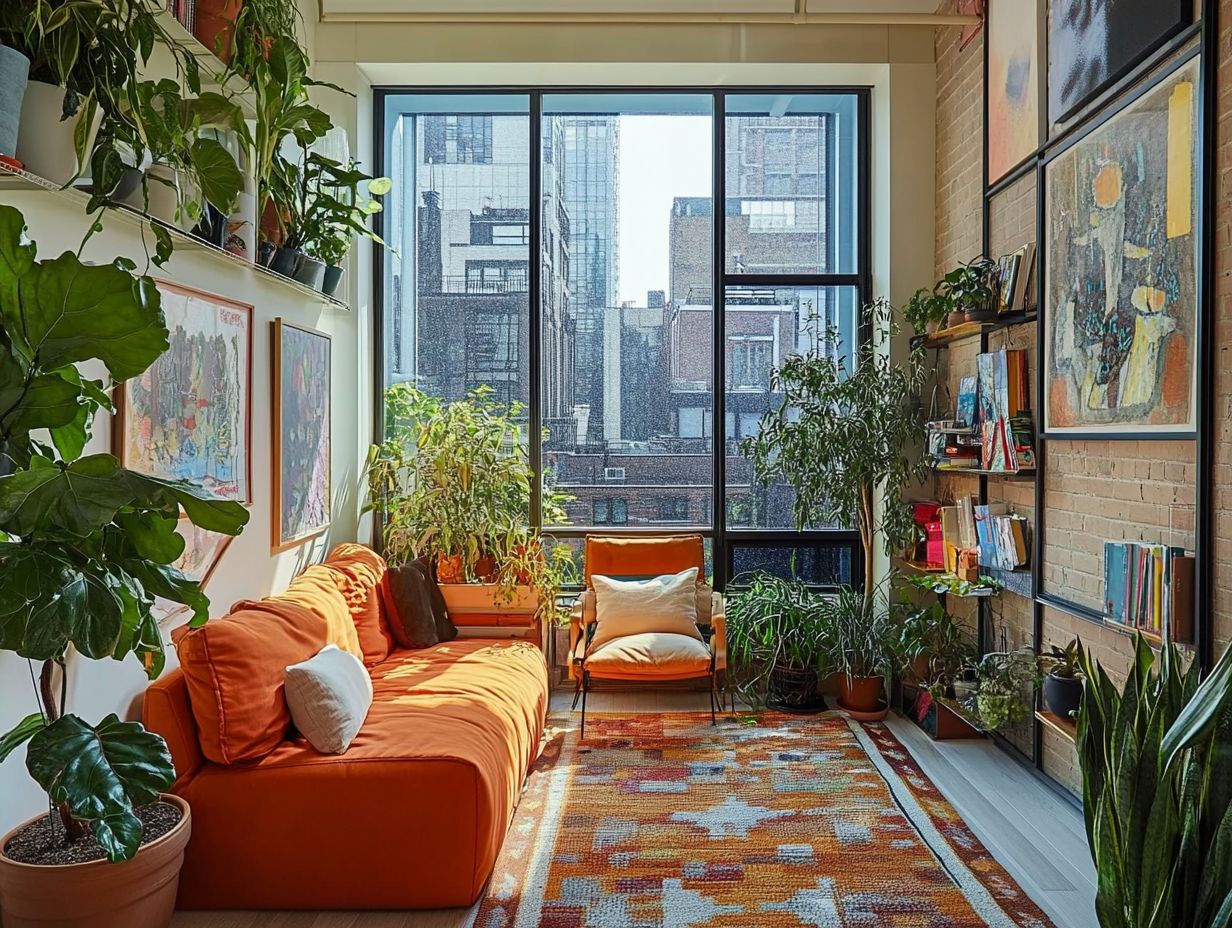
In tiny homes, thoughtful design elements are essential for maximizing usable space, ensuring that every nook has a functional purpose. By incorporating effective furniture layouts, multi-functional pieces, and clever storage solutions, you can enhance your living experience while keeping your environment stylish and organized.
Imagine strategically placing furniture, like a sofa that transforms into a bed or a dining table that folds away when it’s not in use. This allows for smooth transitions between activities, whether you’re unwinding or entertaining guests. Incorporating 5 essential design principles for tiny homes, along with vertical storage options such as shelves and hooks, capitalizes on often-overlooked wall space and minimizes clutter.
These design strategies create more open areas while fostering a sense of comfort and coziness. Even in smaller spaces, you can enjoy both efficiency and aesthetic appeal! For those interested in innovative approaches, designing a tiny house for family living can offer valuable insights.
What Are Some Examples of Multi-Functional Furniture for Tiny Living?
Multi-functional furniture is your secret weapon for thriving in tiny living spaces. These pieces offer versatile solutions that effortlessly adapt to your ever-changing needs. Imagine fold-down tables that shift from dining to desk mode or convertible sofas that provide extra sleeping space when guests arrive. Compact appliances showcase innovative design while saving those precious square feet.
Think about wall-mounted shelving units that double as both storage and display areas to maximize your vertical space. Nesting tables are another genius choice, allowing easy rearrangement and conveniently tucking away when not in use to keep clutter at bay.
Then there s the murphy bed, which folds up effortlessly, transforming your living area into a spacious haven during the day.
Don’t overlook ottomans that cleverly double as storage bins, combining utility with a stylish flair. Each of these solutions contributes to a highly functional environment, proving that thoughtful design can dramatically enhance the practicality of compact living, especially when considering the must-have features in your tiny house bathroom.
How Can Natural Light Be Incorporated into Tiny Homes?
Incorporating natural light into your tiny home is essential for crafting open and inviting spaces. This elevates both design aesthetics and energy efficiency! Use large windows, skylights, and thoughtfully planned room layouts to drastically enhance ambiance, making your space feel larger and more breathable.
Consider using reflective surfaces think mirrors or light-colored walls to amplify brightness and create a seamless flow of light throughout your home. Strategically placed openings can capture the sun s path, allowing different areas to bask in sunlight at various times of the day.
This approach fosters a positive atmosphere that boosts your mood and well-being. It also reduces your reliance on artificial lighting, helping you save on energy costs. Imagine the bright and uplifting atmosphere this creates! Embracing natural light can transform compact living into an uplifting and enriching experience.
Don’t miss out on the chance to transform your tiny space into something extraordinary!
What Are Some Creative Storage Solutions for Tiny Living?
Creative storage solutions are crucial in tiny living environments. They enable you to maintain order and accessibility in compact spaces. Consider innovative options like under-stair drawers, portable walls with built-in shelves, and hidden compartments in your furniture. These strategies maximize your storage potential while preserving your home s aesthetic appeal.
Incorporating furniture that serves more than one purpose like ottomans with hidden storage or folding tables allows you to make the most of every inch without compromising on style. Shelves that go up towards the ceiling not only draw the eye upward but also serve as striking statement pieces while keeping your essentials within reach.
Utilizing baskets and decorative boxes helps categorize items, making it easier to locate your belongings. Stay organized and thrive in your space with these fantastic tips! A clutter-free lifestyle enhances your mental clarity, allowing you to fully enjoy your limited space.
Frequently Asked Questions
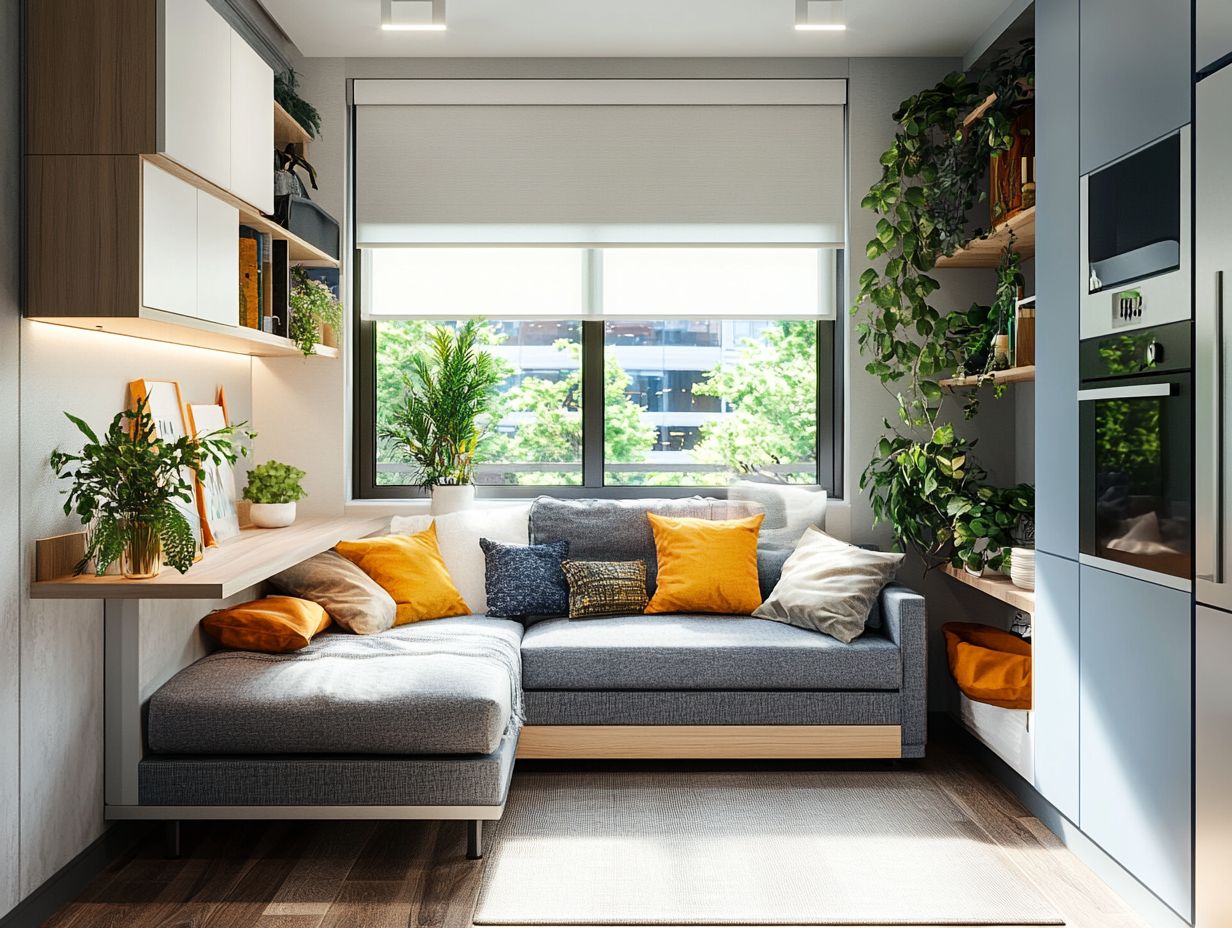
What are the 5 essential design elements for tiny living?
The 5 essential design elements for tiny living include:
- Furniture that serves more than one purpose
- Space-saving storage
- Natural lighting
- A neutral color palette
- Efficient use of vertical space
How can multifunctional furniture enhance tiny living spaces?
Furniture that serves more than one purpose, like a sofa that can also be used as a bed or a coffee table with hidden storage, saves valuable space in a tiny living area while still providing necessary functionality.
Why is space-saving storage important in a tiny living environment?
In a small living space, every inch counts. Incorporating space-saving storage solutions, like wall-mounted shelves or under-bed storage, helps keep the area organized and clutter-free.
What role does natural lighting play in tiny living design?
Natural lighting is crucial in a tiny living space as it creates the illusion of a larger area and makes the space feel more open and airy. Natural lighting also reduces the need for artificial lights, saving energy and money.
How does a neutral color palette benefit tiny living design?
Using a neutral color palette, such as shades of white, beige, or gray, helps make a tiny living space appear larger and more cohesive. It also provides a blank canvas for incorporating pops of color through decor or accents.
How can vertical space be utilized effectively in tiny living design?
In a tiny living space, utilizing vertical space is essential for maximizing the area. This can be achieved through the use of wall-mounted shelves, hanging plants, and lofted beds or storage units.
What s the best way to maximize storage in my tiny home? Start transforming your tiny space today with these creative ideas!

